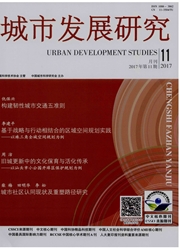

 中文摘要:
中文摘要:
试图从土地和人口两个要素出发,深化关于城市土地集约利用的认识。基于对“人一地”关系研究中增速比较、协调度指数、异速生长模型等三种方法的评析,认为其研判二者协调关系所采用的“标准”在理论与实证层面存在缺陷,提出将“差异”分析置于研究的核心。采用面板数据(PanelData)模型,以277个建制市1999—2012年的建成区面积和人口数据为基础,发现:2006年以后城市用地的人口增长弹性减弱,即城市更加集约了;然而受政府管理行为如对用地结构的安排等各种因素影响,相似规模的城市差异也很大。为进一步量化城市用地与人口规模增长的共性需求与个性差异,引入“残差分析”的思想,测度了比较视野下城市建成区土地集约利用的更新潜力,发现:珠三角、长三角和福建沿海城市、山东省地级城市的更新潜力较大,此外除了新增建设用地审批受限的特大城市,许多中小城市的建成区城市更新和存量规划也应当给予重视。
 英文摘要:
英文摘要:
This research attempts to start from the two elements of land and population, deepen the understanding about the urban growth management. This paper reviews the traditional three research path on the problem of relationship between land urbanization and population urbanization, which contains " growth rate comparison, coordination index and allometric growing model". It points out that all these methods hold defects theoretically and empirically with the " standard" they use, and places the " difference" in the core of analysis. Using panel data model, taking built-up area and population data of 277 cities from 1999 -2012 as sample, it is found that: the urban population growth elasticity is declining after 2006, namely cities became more intensive; however, due to the government management behavior such as the structure arrangement of land use, big difference exist among cities of similar scale. To further quantify the common needs and individual differences, the paper introduced the idea of " residual analysis" to measure renewal potentiality of urban built areas. It's found that: the regeneration potential of Pearl River Delta, Yangtze River Delta and the coastal cities of Fujian Province, as well as cities in Shandong Province are significant. In addition, urban renewal and inventory planning should also give attention to many small and medium sized cities, as well as those megacities.
 同期刊论文项目
同期刊论文项目
 同项目期刊论文
同项目期刊论文
 期刊信息
期刊信息
